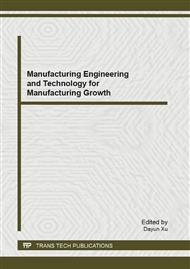[1]
Bureau, Health and Safety Statistics, U.S. Department of Labor, Bureau of Labor Statistics, <http: /www. bls. gov/>, (2010).
Google Scholar
[2]
J. Gong, C. H. Caldas, Data processing for real-time construction site spatial modeling, Auotmation in Construction, 17(2008), 526-535.
DOI: 10.1016/j.autcon.2007.09.002
Google Scholar
[3]
J. Teizer, C.H. Caldas, and C.T. Haas, Real-time three-dimensional occupancy grid modeling for the detection and tracking of construction resources, ASCE Journal of Construction Engineering and Management, 133 (2007), 880.
DOI: 10.1061/(asce)0733-9364(2007)133:11(880)
Google Scholar
[4]
N. Rafibakhsh, J. Gong, M.K. Siddiqui, C. Gordon, H.F. Lee, Analysis of XBOX Kinect Sensor Data for Use on Construction Sites, Construction Research Congress (CRC), Purdue University, Indiana, May 21-23, (2012).
DOI: 10.1061/9780784412329.086
Google Scholar
[5]
S. Chi, C. Caldas, and J. Gong, A crash avoidance framework for heavy equipment control systems using 3D imaging sensors, ITCON, 13 (2008), 118-133.
Google Scholar
[6]
H. Son, C. Kim, and K. Choi, Rapid 3D object detection and modeling using range data from 3D range imaging camera for heavy equipment operation, Automation in Construction, 19 (2010), 898-906.
DOI: 10.1016/j.autcon.2010.06.003
Google Scholar
[7]
E. Stone, and M. Skubic, Evaluation of an Inexpensive Depth Camera for Passive In-Home Fall Risk Assessment, Proceedings, Pervasive Health Conference, Dublin, Ireland, May 21-23, (2011), Best Paper Award.
DOI: 10.4108/icst.pervasivehealth.2011.246034
Google Scholar
[8]
K. Berger, K. Ruhl, Y. Schroeder, C. Bruemmer, A. Scholz, M. Magnor, Markerless Motion Capture using multiple Color-Depth Sensors, Vision, Modeling, and Visualization (VMV), Berlin, Germany, Oct. 4–6, (2011), 317-324.
Google Scholar
[9]
T. Dutta , Evaluation of the Kinect_ sensor for 3-D kinematic measurement in the workplace, Applied Ergonomics, (2011) 1-5.
Google Scholar
[10]
K. Khoshelham, Accuracy Analysis of Kinect Depth Data, International Society for Photogrammetry and Remote Sensing (ISPRS), Zurich, Switzerland, Aug. 25-Sep. 1, (2011).
Google Scholar
[11]
T. Stoyanov, A. Louloudi, H. Andreasson and A.J. Lilienthal, Comparative Evaluation of Range Sensor Accuracy in Indoor Environments, European Conference on Mobile Robots (ECMR), Orebro, Sweden, Sep. 7-10, (2011).
Google Scholar
[12]
Y.J. Chang, S.F. Chen, and J.D. Huang, A Kinect-Based System for Physical Rehabilitation: A Pilot Study for Young Adults with Motor Disabilities, Research in Developmental Disabilities, 32 (2011) 2566-2570.
DOI: 10.1016/j.ridd.2011.07.002
Google Scholar


